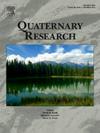Precisely constrained 134-ka strong monsoon event in the penultimate deglaciation by an annually laminated speleothem from the Asian monsoon domain
IF 1.8
3区 地球科学
Q3 GEOGRAPHY, PHYSICAL
引用次数: 0
Abstract
Abstract The penultimate deglaciation was characterized by a sub-millennial-scale warm event in the Heinrich Stadial 11(HS11), termed the 134-ka event. However, its precise timing and structure remain poorly constrained due to the lack of high-resolution and precisely dated records. We present an oxygen isotope record of a speleothem with well-developed annual lamina from Zhangjia Cave, located on the north margin of the Sichuan Basin, characterizing Asian summer monsoon (ASM) changes in the 134-ka event, which included an increase excursion of ca. 149 years and decrease excursion of ca. 200 years, inferred from 3.3‰ δ 18 O variations. This event also divided the weak ASM interval-II (WMI-II), corresponding to HS11, into two stages, the WMI-IIa 132.8–134.1 ka and WMI-IIb 134.4–136.4 ka. With a comparable climatic pattern globally, the 134-ka event is essentially similar to the millennial-scale events in last glacial–deglacial period. Particularly, the observed weak-strong-weak ASM sequence (138.8–132.8 ka) is largely controlled by changes in the Atlantic Meridional Overturning Circulation (AMOC) forced by the meltwater of northern high-latitude ice sheets. Moreover, our results underpin that AMOC, rather than the global ice volume, is more critical to ASM variations during the last two deglaciations.利用亚洲季风区年度层压岩洞精确约束第二次消冰期134-ka强季风事件
第二次消冰期的特征是Heinrich Stadial 11(HS11)的一次次千年尺度的变暖事件,称为134-ka事件。然而,由于缺乏高分辨率和精确日期的记录,其精确的时间和结构仍然受到很差的限制。本文利用四川盆地北缘张家洞年层发育的岩洞氧同位素记录,分析了亚洲夏季风(ASM)在134ka事件中的变化,由3.3‰δ 18o变化推断出了约149年的增加偏移和约200年的减少偏移。该事件还将与HS11对应的弱ASM区间- ii (WMI-II)划分为WMI-IIa 132.8 ~ 134.1 ka和WMI-IIb 134.4 ~ 136.4 ka两个阶段。在全球可比较的气候模式下,134-ka事件与末次冰期-去冰期的千年尺度事件基本相似。其中,138.8 ~ 132.8 ka的弱-强-弱ASM序列在很大程度上受北部高纬度冰盖融水导致的大西洋经向翻转环流(AMOC)变化的控制。此外,我们的研究结果支持AMOC,而不是全球冰量,在最近两次冰川消融期间对ASM变化更为关键。
本文章由计算机程序翻译,如有差异,请以英文原文为准。
求助全文
约1分钟内获得全文
求助全文
来源期刊

Quaternary Research
地学-地球科学综合
CiteScore
4.70
自引率
8.70%
发文量
57
审稿时长
3 months
期刊介绍:
Quaternary Research is an international journal devoted to the advancement of the interdisciplinary understanding of the Quaternary Period. We aim to publish articles of broad interest with relevance to more than one discipline, and that constitute a significant new contribution to Quaternary science. The journal’s scope is global, building on its nearly 50-year history in advancing the understanding of earth and human history through interdisciplinary study of the last 2.6 million years.
 求助内容:
求助内容: 应助结果提醒方式:
应助结果提醒方式:


